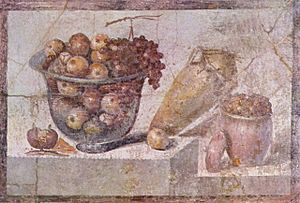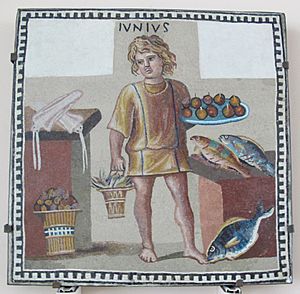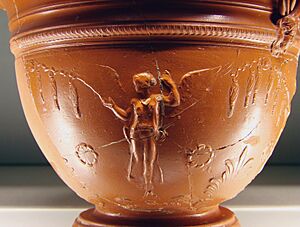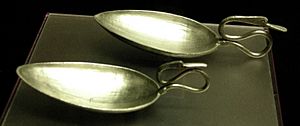Roman food facts for kids

Roman food mostly came from the Mediterranean area and Gaul (which is now France). Romans enjoyed many different foods thanks to the trade networks of the Roman Republic and the Empire. Making sure the city of Rome had enough food was a very important job for its leaders, especially in the later Republic. It was one way the emperor showed he cared for the Roman people.
Romans usually ate three meals a day, much like we do today. In the morning, they had a breakfast called the ientaculum right at dawn. Later, around 11:00 am, they ate a small lunch. In the evening, they had the cena, which was the main meal of the day. During the Empire period, the cena became bigger and had more types of food. It was then eaten in the afternoon. A light evening meal called the vesperna was stopped, and a second breakfast, the prandium, was added around noon.
For ordinary working people, the old meal routine stayed the same. This schedule fit better with their daily manual labor.
Originally, Romans ate flat, round loaves made from emmer, a grain similar to wheat, with a little salt. Wealthier Romans also ate eggs, cheese, and honey, along with milk and fruit. Around the beginning of the Christian era, during the Empire period, bread made from wheat became common. Over time, more and more wheat foods replaced emmer bread. Poor Romans usually ate bread, vegetables, soup, and porridge. Meat and shellfish were expensive, unless they lived in the countryside and could hunt or fish.
Sometimes, bread was dipped in wine and eaten with olives, cheese, and grapes. Romans also ate wild boar, beef, sausages, pork, lamb, duck, goose, chickens, small birds, and fish. They liked to make mealtimes fun. For example, they would roast hare (a type of rabbit) and stick wings on it to make it look like a flying horse!
At dinner, slaves would give guests small, warm bread rolls. These were used to wipe their plates clean. Roman flour often contained dust and small bits. This made the bread so rough that it wore down people's teeth over time. Wealthier Romans enjoyed very fancy foods. These included snails prepared with milk, or even rare items like peacock's brains and flamingo tongues.
The Main Meal: Cena
For wealthy Romans who didn't do physical work, all their business was done in the morning. After their midday meal (the prandium), they would visit the public baths. Around 2 p.m., the cena would begin. This meal could last late into the night, especially if guests were invited. It was often followed by more drinks.
In the time of the kings and the early Republic, and also for working people later on, the cena was mainly a type of porridge called puls. The simplest puls was made from emmer, water, salt, and fat. A fancier version was made with olive oil and served with different vegetables when they were available. Richer people ate their puls with eggs, cheese, and honey. Sometimes, it was also served with meat or fish.
As the Republic continued, the cena grew to have two parts: a main course and a dessert with fruit and seafood, like molluscs or shrimp. By the end of the Republic, it was common for the meal to have three parts: a first course (gustatio), the main course (primae mensae), and dessert (secundae mensae).
Food for Ordinary People
Unlike the fancy banquets of the rich, ordinary people ate the cheapest foods. For breakfast, they had grain made into twice-baked bread and porridge. For lunch, they ate a stew made of vegetables and sometimes meat. Common vegetables included millet, onions, turnips, and olives, often with bread and oil.
At dinner, they might have thin soup or meat with cheese, and a pudding made with honey.
Roman Drinks
The main drink for Romans was wine, which was popular across the Empire, along with water. Wine could be mixed with spices and honey to make it taste better. Slaves would pour wine and honeyed water into flasks and fill goblets from large serving dishes. Drinks like milk were not considered proper for adults and were only used for children, for medicine, or for making cheese. Wine was produced in Italy, Africa, Gaul, Spain, and Greece and then shipped all over the Empire. Romans in Britain also drank beer.
Roman Kitchens
Roman kitchens were usually small rooms. They had simple equipment like built-in clay ovens and wooden cupboards. A charcoal fire heated a brick hearth, where cooks would fry or cook food in earthenware or bronze pots. They also used the hearth for baking or roasting. Meats were sometimes placed directly in the ashes to cook. Roman kitchens were quite small compared to modern kitchens. A kitchen would also have large jars of olive oil, wine, vinegar, and fish sauces. There would also be a mortar for grinding spices. Only wealthier people had kitchens, but they didn't cook themselves; their slaves did the cooking. Even with simple tools, the cooks and slaves made flavorful dishes with shellfish, wild boar, fruits, and sweets.
See also





